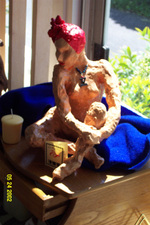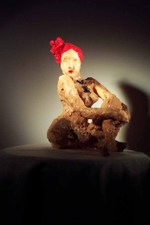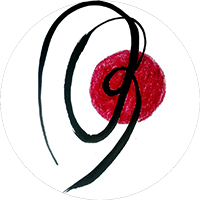
 Hand-build clay sculpture, Glitter, by Tammy Vitale of Tam’s Originals
Hand-build clay sculpture, Glitter, by Tammy Vitale of Tam’s Originals
Into my mailbox yesterday came "Creative Wisdom," Sculptural Pursuit magazine’s monthly ezine. I always enjoy it, and yesterday’s issue was no different. Additionally, it brought along the best and most succint checklist for success as an artist I have ever read.
Nancy DeCamillis writes, in "Steps on the Path to Success:"
- Determine if you have the skills, abilities, and the personality to be an artist. [patience, persistance, self-motivation, self-promotion, thick skin, organizational skills, flexibility and fearlessness]
- Spend time in the studio on a regular basis for a set amount of time each day and create a group of works with a consistent theme. Complete ten to fifteen pieces with a harmonious flow that identify your style before entering shows or approaching galleries.
- Keep your work fresh and original for your own excitement and for your audience. Spend time researching ideas and themes for creating new art. If you feel stuck and need fresh ideas, visit museums and art exhibits or sketch or photograph inspiring images in nature, of people, of buildings, or of the world around you.
- For your personal records, photograph your work in progress and when finished. More importantly, hire a professional to photograph your work for entering competitions and juried shows and for advertising. The primary complaint from exhibit and competition organizers, publications, and galleries is the poor quality of the photographs many artists submit. Your work deserves the best presentation you can give it. Note from me: the art world is currently starting to catch up with the world of technology and many venues call for work on CDs now which makes it much easier, much more in the artist’s control and much less expensive to make and submit good photos of work. You do need a good digital camera and computer ("less expensive" assumes you already have these in your life). Some photographers own the image of your work and will charge you accordingly each time you use it. Be sure to check out the details before you hire a photographer.
- Prepare your artist’s statement (about one-third of a page long), resume (two pages), and a biography (one page). Make copies of any articles or press coverage of your work. Keep this information updated and on file so that you can send it out at a moment’s notice.
- Create a professional portfolio containing an introductory letter, resume, artist’s statement, and biography, as well as photographs and slides or a disk of your current work and an inventory list of the pieces. Label photos and slides with the title, medium, size, and your name. This is your presentation to galleries, prospective clients, and other art professionals. Note from me: Often shows call for particular labeling of slides. Follow their directions explicitly as opposed to this generic suggestion. Keep acetone (fingernail polish remover) on hand to clean the slides of old labeling. Pray that all venues will soon only require digital submission.
- Accumulate names of people interested in your work and keep your mailing lists updated. Send out notices of new exhibits, articles aout your art, press releases, show schedules, and newsletters. Keep in touch on a regular basis. Note from me: Check out Artbiz’s "Cultivating Collectors" publication
- Routinely seek out exposure by sending your portfolio to galleries, calling potential buyers, and applying for various grants and fellowships.
- Organize your own studio show once a year. Make it a private show or invite other artists to participate with you. Hold it in your studio or in a friend’s home, or approach a local business such as a bank, office building, or interior design store to show your work (Check out the article "Tips of the Trade, Innovative Art Exhibit Venues" in Sculptural Pursuit’s Fall 2003 issue, Vol 2 No 4 for an interesting alternative exhibit space.)
- Note from me: Don’t forget that you can build your press file by issuing regular releases on your work and participation in events. Refer to "Free Press" archives here for how to.
Thought for the day: "The critical point to rememer is that the more we think about anything, whether it’s something we want in our lives or something we don’t want, the faster we’re going to magnetize it into our experience. That, in a nutshell, is the universal Law of Attraction: ‘That which is like unto itself is drawn.’" Lynn Grabhorn, Excuse Me, Your Life is Waiting: the astonishing power of feelings
note from me: that this is a universal law is a paradox. If someone says to you, "don’t look!" what’s the first thing you do? So the law says: think only of the things you want, not the things you don’t want….what’s the first thing you think of? Is it only my mind that goes immediately to what I don’t want? Breathe. Release. Breathe. Release.


